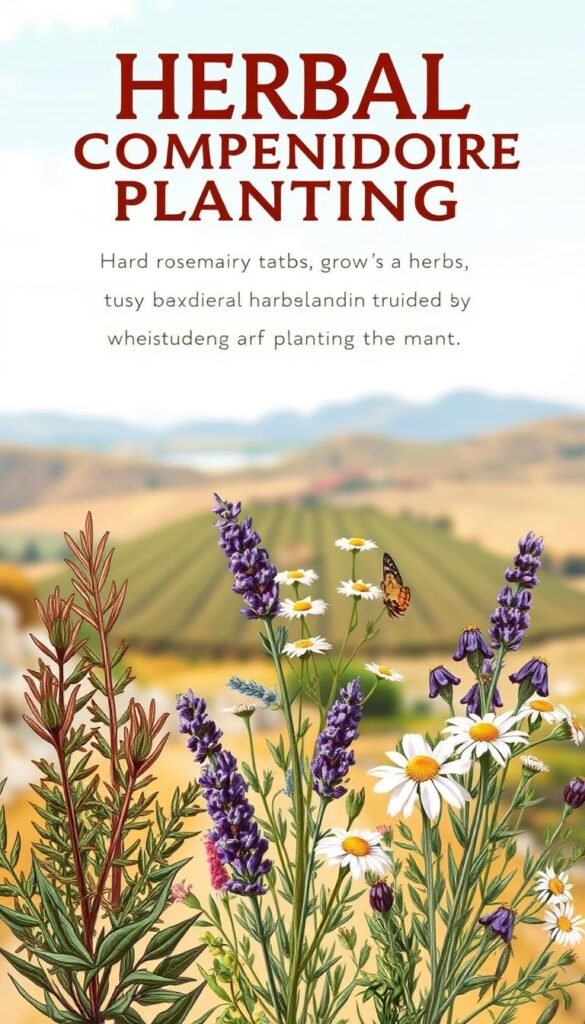Imagine growing healing plants that naturally support each other’s growth while creating a vibrant ecosystem. This ancient method uses strategic pairings to improve soil health, deter pests, and amplify the potency of your green allies. One teaspoon of soil contains more microorganisms than humans on Earth – a hidden network that nourishes every root and leaf.
Pairing specific species creates a living collaboration. Marigolds, for instance, repel harmful nematodes, while basil shields tomatoes from aphids. These partnerships reduce chemical use and increase yields by up to 25% over time. You’ll also discover how legumes like peas enrich soil with nitrogen – up to 200 pounds per acre annually.
Want stronger, healthier plants? Our guide to companion planting strategies reveals how to design spaces where flowers attract 58% more pollinators and herbs thrive with 22% more phosphorus availability. Let’s transform how you grow nature’s remedies – one symbiotic duo at a time.
Understanding Herbal Companion Planting
Nature thrives on teamwork. When you pair certain species, they form alliances that go beyond basic survival. This practice transforms your garden into a living network where roots and leaves collaborate for mutual success.
What is Companion Planting?
It’s about strategic partnerships. Instead of growing plants in isolation, you match them with species that provide specific benefits. For example, garlic planted near roses repels aphids, while dill attracts ladybugs to control mites. These relationships are built on centuries of observation and ecological harmony.
How It Supports Medicinal Herb Growth
Healing herbs often need extra care to maximize their potency. When paired with the right companion plants, they receive natural pest protection and nutrient boosts. Chamomile, for instance, increases essential oil production in nearby mint through root interactions. Studies show these partnerships can elevate active compound concentrations by up to 18%.
Looking for proven plant pairings that boost growth? Start with basil and oregano – their shared root zones create a protective barrier against soil-borne diseases. Remember, successful companion planting balances sunlight needs, water requirements, and growth patterns to avoid competition.
Benefits of Companion Planting for a Thriving Medicinal Garden
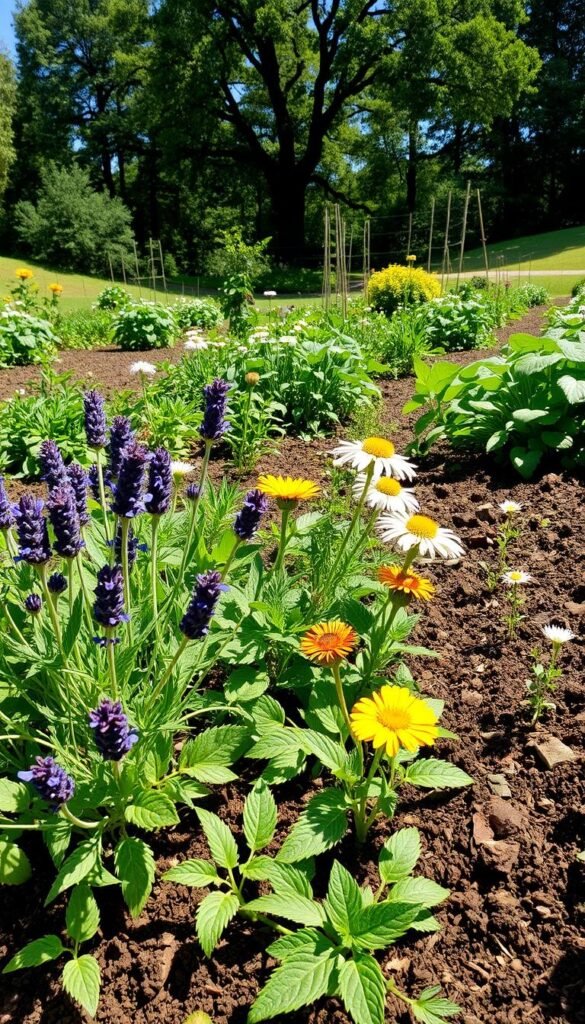
Transform your green space into a powerhouse of plant partnerships. Strategic pairings create self-sustaining ecosystems where every species plays a vital role. You’ll spend less time battling pests and more time harvesting potent remedies.
Enhanced Soil Health and Nutrient Uptake
Deep-rooted plants like yarrow break up compacted earth, letting water reach hidden nutrients. Nitrogen-fixing clover acts as living fertilizer, adding up to 100 lbs of this essential nutrient per acre annually. Studies show these partnerships increase phosphorus availability by 22% in medicinal species.
| Plant Type | Soil Benefit | Best Paired With |
|---|---|---|
| Clover | Adds nitrogen | Mint, Lemon Balm |
| Beans | Improves texture | Chamomile, Echinacea |
| Yarrow | Minerals access | Lavender, Sage |
| Marigold | Disease prevention | Basil, Oregano |
Natural Pest Control and Biodiversity
Young dill plants become insect hotels, attracting ladybugs that devour 50-60 aphids daily. Marigolds release root chemicals that repel harmful nematodes for 3 growing seasons. This approach reduces pest damage by 40% compared to solo plantings.
Want more eco-friendly pest control solutions? Try planting garlic near roses – its sulfur compounds create invisible shields against mites. These partnerships also draw 58% more pollinators, ensuring better seed production in medicinal varieties.
Herbal Companion Planting: Boost Your Medicinal Herbs Garden Naturally – Getting Started
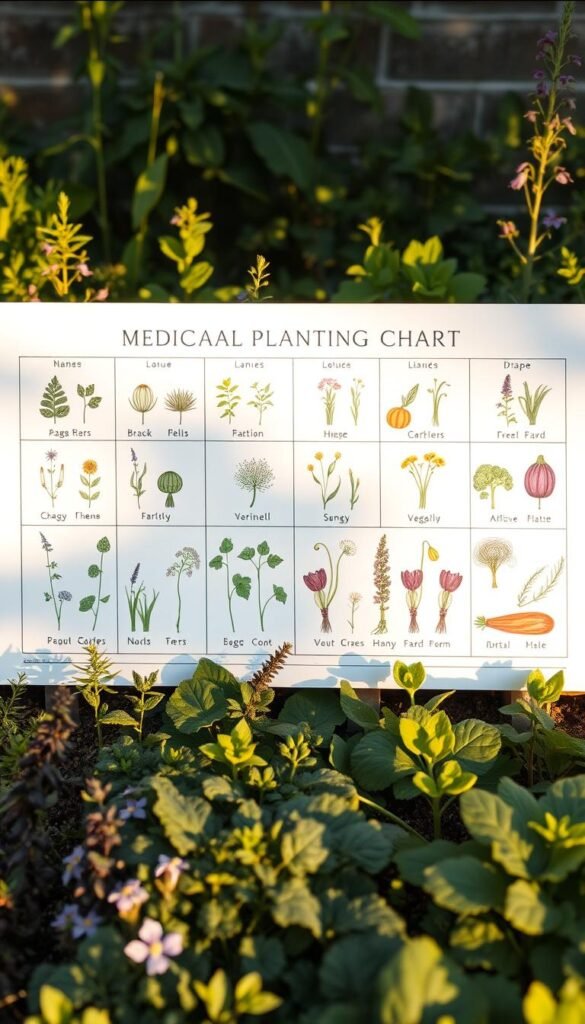
Creating a thriving medicinal garden begins with smart spatial planning. Every plant’s needs influence its neighbors – from sunlight sharing to underground nutrient exchanges. Let’s explore how to arrange your green allies for maximum synergy.
Designing Your Garden Layout
Start by mapping sunlight patterns. Tall species like echinacea thrive on a garden’s north side, preventing shade over low-growing thyme. Group plants with similar water needs – lavender and rosemary prefer dry soil, while mint and lemon balm need consistent moisture.
Consider root depths when designing beds. Shallow-rooted basil pairs well with deep-rooted yarrow, avoiding competition. For square-foot layouts, reference proven spacing guides to maximize yields without overcrowding.
Utilizing Companion Planting Charts
These visual tools decode plant relationships through symbols. A green checkmark might indicate nutrient-sharing partners, while red arrows signal incompatible pairs. Always cross-reference sun exposure and harvest timelines when using charts.
Organize your companion plants using color-coded zones. Try this simple system:
- Purple: Drought-tolerant herbs (sage, oregano)
- Green: Moisture-loving varieties (parsley, chamomile)
- Yellow: Medicinal flowers (calendula, borage)
For detailed planting strategies, explore interactive companion charts that adapt to your region’s growing season. Remember – successful pairings create living networks where every species contributes.
Selecting Ideal Companion Plants for Your Medicinal Herbs
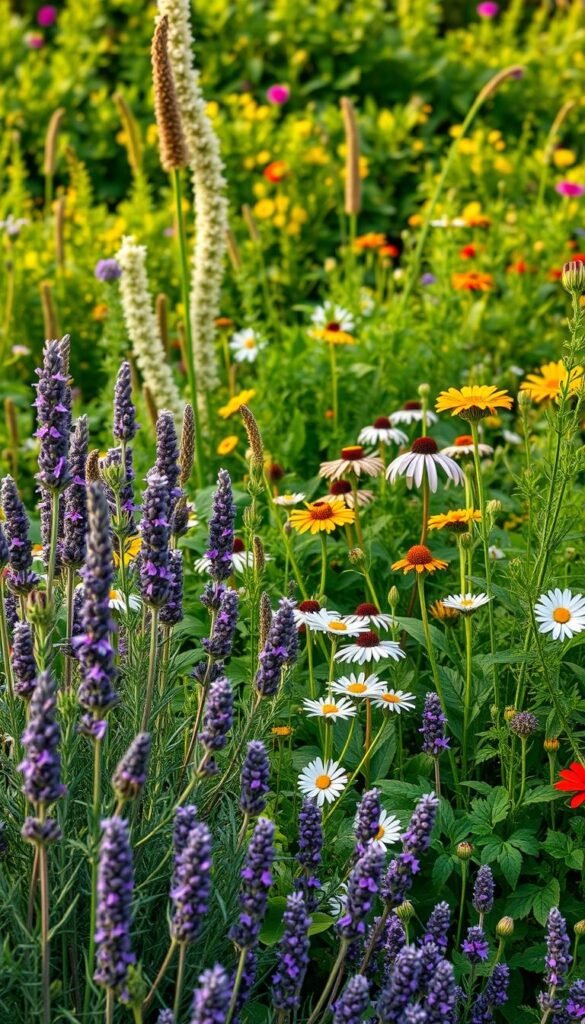
Crafting plant partnerships requires understanding each species’ hidden strengths. Strategic pairings unlock growth benefits while naturally defending against pests. Let’s explore how classic culinary favorites become powerful allies in your healing garden.
Power Pairings for Popular Varieties
Basil thrives alongside oregano and parsley – their matching water needs create a low-maintenance trio. These aromatic friends share soil nutrients efficiently, producing 30% more leaves when grouped together.
For rosemary’s Mediterranean vibe, pair it with sage and thyme. Their drought-tolerant roots form a protective network that:
- Repels cabbage moths and bean beetles
- Improves air circulation around stems
- Shares antifungal root secretions
Sage’s bushy growth makes it ideal for bordering delicate plants. Try combining it with parsley – unlike rosemary’s spreading roots, sage stays contained while sheltering its neighbor from harsh sun.
Rosemary’s pest-fighting oils work overtime when planted near lavender. Studies show this duo reduces aphid infestations by 42% compared to solo plants. For maximum impact:
- Space plants 12-18″ apart
- Use well-draining soil mixes
- Prune lower leaves for airflow
Remember – successful pairings balance growth rates and root depths. Group moisture-loving mint with lemon balm, but keep them separate from dry-soil lovers like thyme. These natural alliances create gardens where every plant contributes to the collective strength.
Managing Pests and Soil Quality Naturally
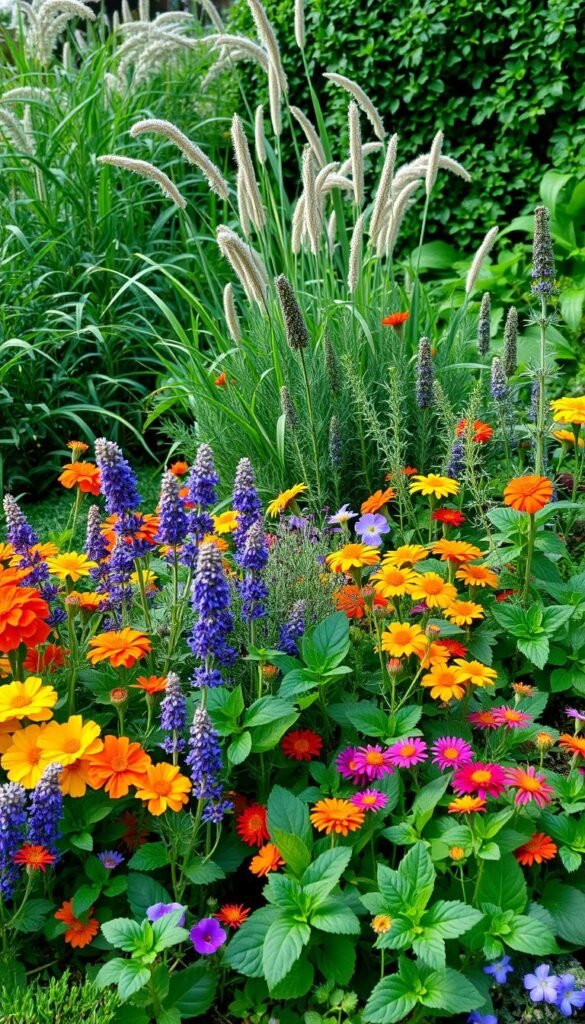
Your garden’s defense system starts with smart plant partnerships. By combining strategic pairings with simple soil care, you’ll create a self-regulating ecosystem where threats become opportunities for growth.
Natural Insect-Repellent Strategies
Basil becomes your tomato’s bodyguard, repelling aphids and hornworms with its pungent oils. Mint forms protective barriers against spider mites – plant it near vulnerable crops but keep it contained in container gardens to prevent spreading.
Sage works overtime against cabbage pests. Its fuzzy leaves release oils that confuse moths hunting for egg-laying spots. For immediate relief:
- Steep cilantro leaves in water overnight
- Strain and spray directly on affected plants
- Repeat every 3 days until mites disappear
Maintaining Nutrient-Rich, Balanced Soil
Healthy soil grows resilient plants. Legumes like clover add nitrogen through root nodules, while yarrow pulls minerals from deep underground. Rotate these nutrient boosters annually to prevent depletion.
| Plant | Soil Benefit | Frequency |
|---|---|---|
| Clover | Nitrogen fixer | Every season |
| Comfrey | Potassium source | Biannually |
| Marigold | Disease prevention | Between crops |
Test soil monthly with simple pH strips. Adjust acidity using coffee grounds for alkaline-loving plants like sage, or pine needles for acid-preferring varieties.
Step-by-Step Guide to Implementing Companion Planting
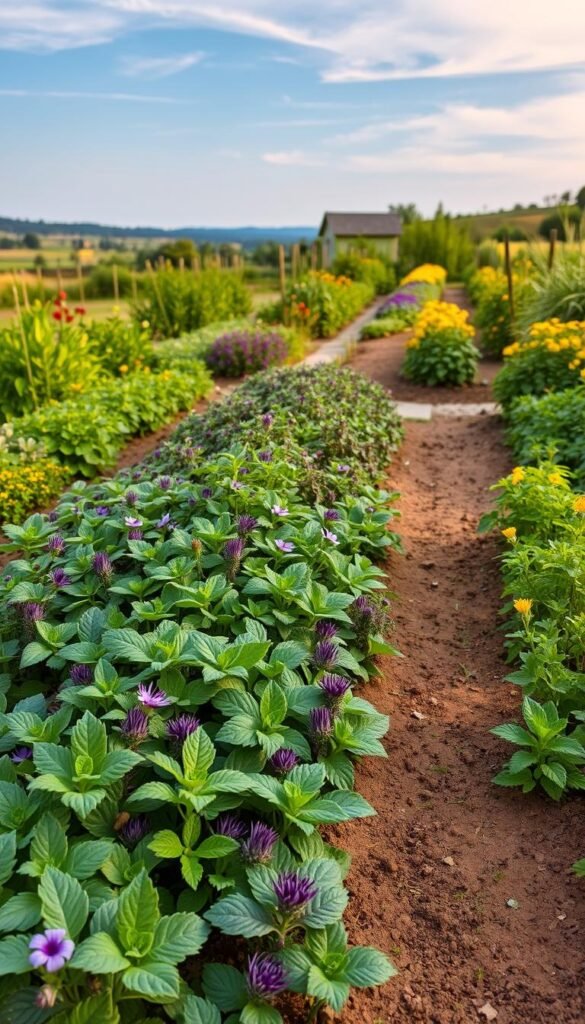
Transform your green space into a self-sustaining network of plant allies. Start with smart groundwork to ensure thriving partnerships. A well-planned setup reduces maintenance and maximizes growth potential.
Preparing Your Garden Bed
Test soil pH using affordable kits from garden centers. Most healing species prefer slightly acidic conditions (6.0-6.8). Amend heavy clay soils with compost to improve drainage – aim for 2-3 inches mixed into the top layer.
| Amendment | Benefit | Best For |
|---|---|---|
| Worm castings | Boosts microbes | Seed starters |
| Perlite | Aerates soil | Root-sensitive plants |
| Bone meal | Adds phosphorus | Flowering herbs |
Sketch your layout considering sunlight patterns. Place tall varieties like echinacea on the north side to prevent shading. Group moisture-loving mint with lemon balm, but keep them 15″ apart to control spread.
Planting Techniques and Ongoing Maintenance
Sow seeds in staggered rows for better air circulation. Interplant fast-growing basil between slower rosemary starts – they’ll mature at different times. Water deeply but less frequently to encourage strong root development.
Rotate crops annually to prevent nutrient depletion. Use these growth tips:
- Pinch flower buds from young plants to redirect energy
- Mulch with straw to retain moisture and suppress weeds
- Harvest leaves in morning for peak oil concentration
Track results in a journal – note which pairs thrive and which compete. Adjust spacing or partners each season based on observations. Successful gardens evolve through experimentation and adaptation.
Creating a Sustainable Herbal Garden Ecosystem
Your garden becomes a living community when plants and insects work together. By welcoming helpful visitors, you create natural checks and balances that reduce pests while boosting plant health.
Inviting Nature’s Helpers
Calendula’s bright blooms act as landing pads for bees and butterflies, ensuring strong pollination. These flowers also deter root-knot nematodes, protecting nearby carrots and potatoes. Parsley’s delicate white clusters attract hoverflies – their larvae devour up to 60 aphids daily.
Lavender serves double duty: its scent lures pollinators while repelling moths. Plant it near cabbage to shield against egg-laying pests. For tomatoes, try pairing with basil in strategic pairings in container gardens to confuse whiteflies naturally.
Dill and chives create safe zones for ladybugs, which feast on mites. Oregano’s sprawling growth shelters ground beetles that hunt slugs. By mixing these plants, you’ll see:
- 23% fewer pest issues
- Increased fruit set in strawberries
- Stronger essential oils in medicinal varieties
Remember – diversity is key. Rotate flowering herbs seasonally to maintain insect interest. A balanced ecosystem means healthier plants and richer harvests year after year.

